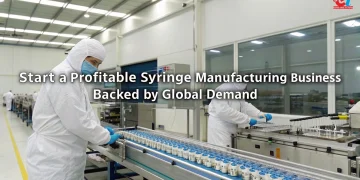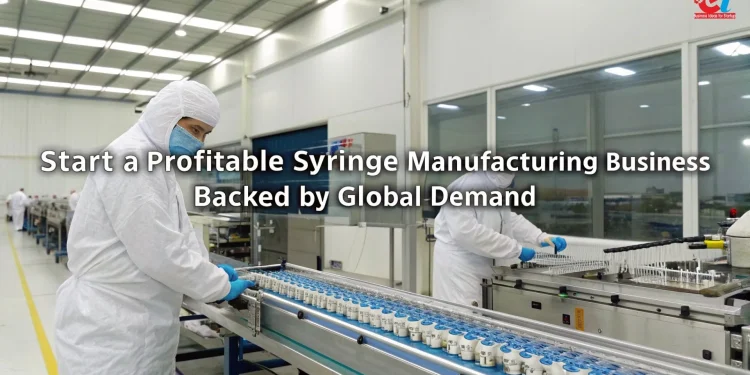Few products are as essential and as widely employed as disposable Syringe Manufacturing are in the systemized ecosystem of world health care. These single-use medical devices have been the foundation of contemporary medicine, permitting the secure and effective administration of vaccines, therapeutic drugs, and even diagnostic agents. Their significance was heightened during the COVID-19 pandemic when mass immunization campaigns brought to the fore the critical contribution of syringes in public health.
But even beyond pandemics, the global need for disposable syringes continue to expand due to rising vaccination drives, including those related to the management of chronic ailments, greater healthcare accessibility, and the burgeoning pharmaceutical and biotechnology industries.
More than medical supplies, disposable syringes serve to achieve the guarantee of safety, prevention of infection, and granting the opportunity for life-saving treatments to millions of patients. With the growing population more conscious about health, coupled with government spending on immunization and health infrastructure, the syringe market is experiencing a surge in demand in both developed and developing countries.
This article examines the persisting and growing global demand for disposable syringes, focusing on strategic factors, changing uses, regional areas of growth, and the enduring prospects for manufacturers and healthcare distributors.
The Critical Importance of Disposable Syringes to Healthcare Today
Physicians use disposable syringes to both inject and withdraw fluids from the body because they are made of plastic and can only be used once. Unlike reusable syringes, they have a single purpose—they need to be thrown away after use to maintain sterile practices and avoid the spread of infections. Their design—which usually includes a barrel, plunger, and needle—has changed over the years. Today, they are manufactured as auto-disable (AD) syringes, safety syringes, prefilled syringes, retractable syringes, and others, allowing for greater technological accuracy and safety.
Besides vaccinating patients, these types of syringes have other purposes. They are also used to deliver insulin to diabetic patients, administer anesthesia during surgeries, inject hormones, treat allergies, deliver chemotherapy, and more. In diagnostics, blood collection and injection of samples are also done with sterile syringes.
The evolution of these medical procedures requires an even greater dependence on the safe injection practices. In this sense, disposable syringes are the most basic of the medical and therapeutic aids and are the first to be encountered at the primary health center in a rural village or on a patient’s bedside in a surgical ward in a city hospital.
Primary Factors Affecting International Market Demand
The worldwide demand for disposable syringes has been increasing over the years and that is not for no reason; It is due to many factors working together. One of the factors has been the global focus on vaccinations which includes childhood immunizations and adult vaccination drives. Not to mention the COVID-19 vaccination campaign that needed billions of doses over a few months which resulted in an unmatched increase in syringe production. This not only highlighted the importance of good supply chains, but also showed how many syringes are lacking in a lot of under developed countries.
Apart from pandemics, the measles, polio, hepatitis, tetanus and flu vaccination programs at a national scale also support consistent demand. The WHO, GAVI, and UNICEF have also been some of the biggest sponsors providing millions of syringes every year for middle and low income countries.
Moreover, the increased prevalence of chronic conditions around the globe like diabetes, rheumatoid arthritis along with hormonal disorders has resulted in greater adoption of injectable therapies, several of which are administered via syringe on a daily or weekly basis. The rise of biologics in the pharmaceutical industry also demands innovative custom prefilled or safety syringes designed to meet undergoes changes with new drug applications.
The elderly population is rising worldwide, especially in countries such as Japan, Germany, and U.S., which contributes to an increase in hospital admissions and outpatient services. These services require an extensive amount of syringes for multi-faceted diagnosis and treatment.
Related: Disposable Plastic Syringes Business: Profitable Opportunity with Market Insights
Emerging Markets and Regional Dynamics
The North America and Europe region has historically been the most lucrative market owing to their developed healthcare systems coupled with pharmaceutical industries. However, the highest rate of increase in demand for syringes is currently originating from the Asia Pacific, Latin America, and Africa regions. Disposable syringe manufacturing and usage is booming specially in India and China.
In India, the expenditure on public health boosted by the Ayushman Bharat scheme along with investments from the private sector has escalated the usage of syringes in urban and rural healthcare centers alike. Besides serving local demand, China is also a leading supplier for affordable syringes to many regions in Africa, Southeast Asia, and Latin America.
Improved infrastructure for basic healthcare services, the entry of international pharmaceutical companies, and multilateral campaigns targeting HIV, malaria, and tuberculosis create enormous opportunities in Africa. On the other hand, countries such as Brazil, Mexico, and Argentina in Latin America are investing in strengthening their public health systems which creates a need for disposable medical supplies such as syringes.
The rise of medical tourism in countries such as Thailand, India, Singapore, and Turkey also increases the consumption of sterile disposable devices, contributing to the global demand.
Change in Direction Towards the Use of Safety and Auto-Disable Syringes
Safety is essential in the syringe industry. According to WHO, millions of infections, including HIV, hepatitis B and C, are spread each year due to unsafe injection practices. In response, there is a universal demand for auto-disable (AD) and safety-engineered syringes that retract or lock after one-time use.
This is a growing international standard but many regions are also increasingly making it a legal requirement. The Indian government, for instance, mandates the use of auto-disable syringes for all immunization injections. Hospital systems across Europe and North America are making the change to retractable or needle-shielding syringes to prevent post-needle stick injuries to healthcare workers.
The changing trends towards vaccination and biotech drugs which require more sophisticated pharmacy services shifts the focus towards heightened manufacturing and packaging standards. Such advancements, incorporate higher levels of patient compliance alongside minimizing dosage discrepancies and medical waste.
Manufacturing and Supply Chain Considerations
Consequently, the production process for disposable syringes entails the following: molding the plastic (usually polypropylene), producing the stainless steel needle, assembling the components, sterilization (through ethylene oxide or gamma radiation), and packaging. Their compliance with health and safety standards entails abiding to Good Manufacturing Practices (GMP), holding ISO certifications, and fulfilling region specific laws.
Situated in the northern region of India, the main hub for syringe production is identified in the states of Haryana, Gujarat, Maharashtra, Tamil Nadu, and Uttar Pradesh. The firms produce for domestic distributors while the latter exports to more than 80 countries. Due to the newly implemented government subsidies, these subsidized medical devices are anticipated to improve automation and quality control systems enhancing their ability to meet international standards.
The need for efficient logistics and temperature-controlled storage- (especially for prefilled syringes) becomes as important as production. For many multinational pharmaceutical companies, the availability of temperature controlled storage becomes a prerequisite increasing reliance on vendors with complete operations from raw material sourcing request to sterile packaging and last mile delivery.
Market Outlook and Strategic Opportunities
The disposable syringe market is worth over \15 billion and is expected to grow at a CAGR of 6-8% till 2030. Growth is driven by fundamentals like increasing population alongside higher life expectancy, evolving drug delivery methods and the continuing demand for injectables.
There is a big market gap for innovative AD syringe products that aid in smart syringes with dose tracking features. Other opportunities include contract manufacturing for biotech and vaccine companies, and the design and manufacture of environmentally friendly biodegradable or recyclable syringes.
There is growing interest in startups focusing on automation in syringe assembly, or digital enabled usage tracking in the hospital setting. Combined with appropriate medical quality control, access to export markets and safety standards offers a unique and scalable business opportunity in this segment.
Conclusion: Disposable Syringes—A Small Product with a Massive Global Impact
The future of disposable syringes is not just about increasing volumes—it’s about smart, safe, and sustainable delivery of healthcare. Whether it’s protecting a child through vaccination, managing diabetes for an elderly patient, or enabling cutting-edge biologic therapy, the humble syringe plays a pivotal role in millions of lives every day.
For manufacturers, investors, healthcare planners, and governments alike, strengthening the production, distribution, and innovation of disposable syringes is not only good business—it’s a moral imperative in the quest for universal health coverage.Niir Project Consultancy Services (NPCS) provides detailed project reports, technical know-how, layout design, machinery sourcing, compliance support, and financial feasibility planning for entrepreneurs and healthcare businesses in the disposable syringes segment.


























